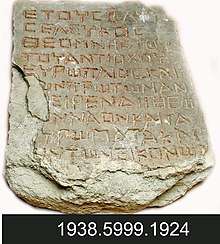Temple of Zeus Theos, Dura Europos
The Temple of Zeus Theos at Dura Europos was built in the second century AD and was among the most important sanctuaries of the city. The structure was located in the centre of the settlement. It had an area of around 37 m2 and took up half an insula. If still in use by the 4th-century, it would have been closed during the persecution of pagans in the late Roman Empire. [1] It was excavated by an American-French team between December 1933 and March 1939.

Description
The entrance to the temple was on the east side. Above it was an inscription which named the builder as one Seleukos and the year of construction as AD 114. It is uncertain whether this date refers to the construction of the gate or of the temple as a whole.[2] The temple complex contained a monumental court, within which there was a large Naos. On the north and south sides of the court there was a series of rooms, most with benches lining all the walls.
The Naos was located on the west side of the court as a free-standing structure. It had four rooms. The largest was the cella. This had wall paintings which were found in tiny fragments but were able to be largely reconstructed. On the back wall, the cult image of the god was depicted. He stood next to a chariot and was crowned by Nike.
On the side walls of the hall, there were three registers of images of the donors who had financed this temple and their family members. Their names were written next to their images. They appear to be the members of two influential families, one of which is known as the family of Lysias. Several inscriptions were found, all in Greek. Next to the cella was a smaller room, which was probably the temple treasury. Some gemstones were found here. A dedicatory inscription on a stele is dated AD 120/121 and was dedicated by one Seleukos.
References
- R. MacMullen, "Christianizing The Roman Empire A.D.100-400, Yale University Press, 1984, ISBN 0-300-03642-6
- M. I. Rostovtzeff, F. E. Brown, C. B. Welles: The excavations at Dura-Europos: Preliminary Report of Seventh and Eighth Season of Work 1933–1934 and 1934–1935. Yale University Press, New Haven u. a. 1939, p. 195.
Bibliography
- M. I. Rostovtzeff, F. E. Brown, C. B. Welles: The excavations at Dura-Europos: Preliminary Report of Seventh and Eighth Season of Work 1933–1934 and 1934–1935. Yale University Press, New Haven u. a. 1939, pp. 181–217.